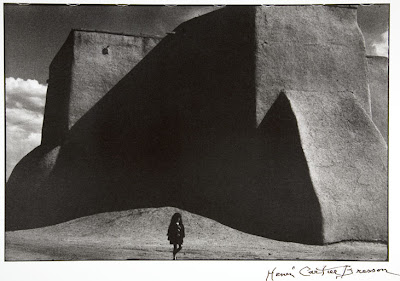
A post to acknowledge and answer some of your comments.
First, a thank you to Christopher Paquette for sending this amazing Lego version of the Van Ess Saigon evacuation picture (above).
In the Church at Rancho de Taos reader response, Adams was the clear winner, followed by Strand. I think this was a smart consensus. I also received the picture below from Christopher Marquez at the Andrew Smith Gallery in Santa Fe. Can you guess who it’s by? Answer at the bottom.
A reader named James asked if I had any opinion on tilt shift photography. I like it a lot when done skillfully. Miklos Gaal, Vincent Laforet, and Olivo Barbieri (see below) seem to be among the best practitioners largely because it seems integral to their vision. But when it’s just a gimmick to try and improve an otherwise dull picture it seems gratuitous.
There was also a request for some helpful advice on how to price photographs. Here’s how I do it. Gather all relevant information. Is there any past pricing to go by? Does it seem right, high, or low? If there’s no direct relevant information look for something similar or equivalent. Is the picture a large scale small edition print or a small scale open edition print? What is the cost of production?
Are you selling directly or through or a dealer. I would say that a reasonably made print of a good image by a serious photographer shouldn’t go for less than $500. The current record for a contemporary piece is in the seven figures but that’s a limited edition print, a signature piece, by a renowned artist. (We’re talking the Prince, Struth, Gursky class here.) So there’s a big range. Depending on your personal philosophy (and financial situation), you can decide whether to err on the side of underpricing or overpricing – but if you trust your gut you’ll probably come up with the right price. The one piece of pricing advice I always give to photographers is: don’t be afraid to sell out an edition. First, it rarely happens. Secondly, if it does you’re a success! Thirdly, you should always have your artist’s proof. And lastly, if you’re any good, there should always be more sale-worthy images in the pipeline.
A good response from readers sending in their own Taos photographs:
 Here and below - two ironic views taken by Robert Wright showing how it is today.
Here and below - two ironic views taken by Robert Wright showing how it is today.
 David Gardner focused on a side door.
David Gardner focused on a side door.
 Mark Harmel found a nice play of shadow and form.
Mark Harmel found a nice play of shadow and form.
And lastly, the Church at Taos surprise answer:







No comments:
Post a Comment